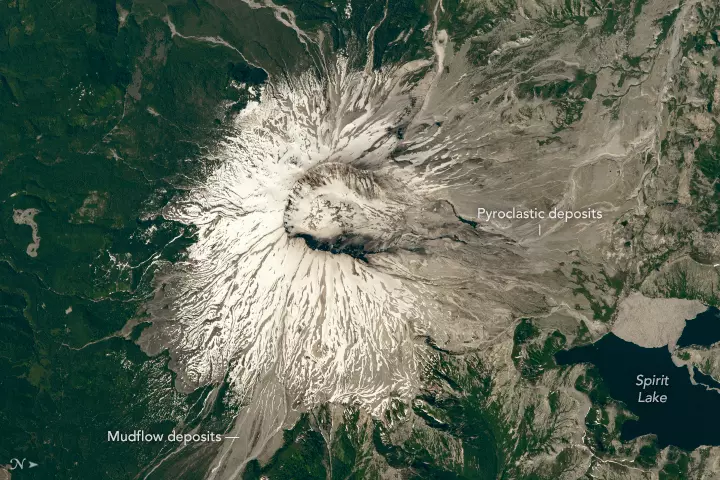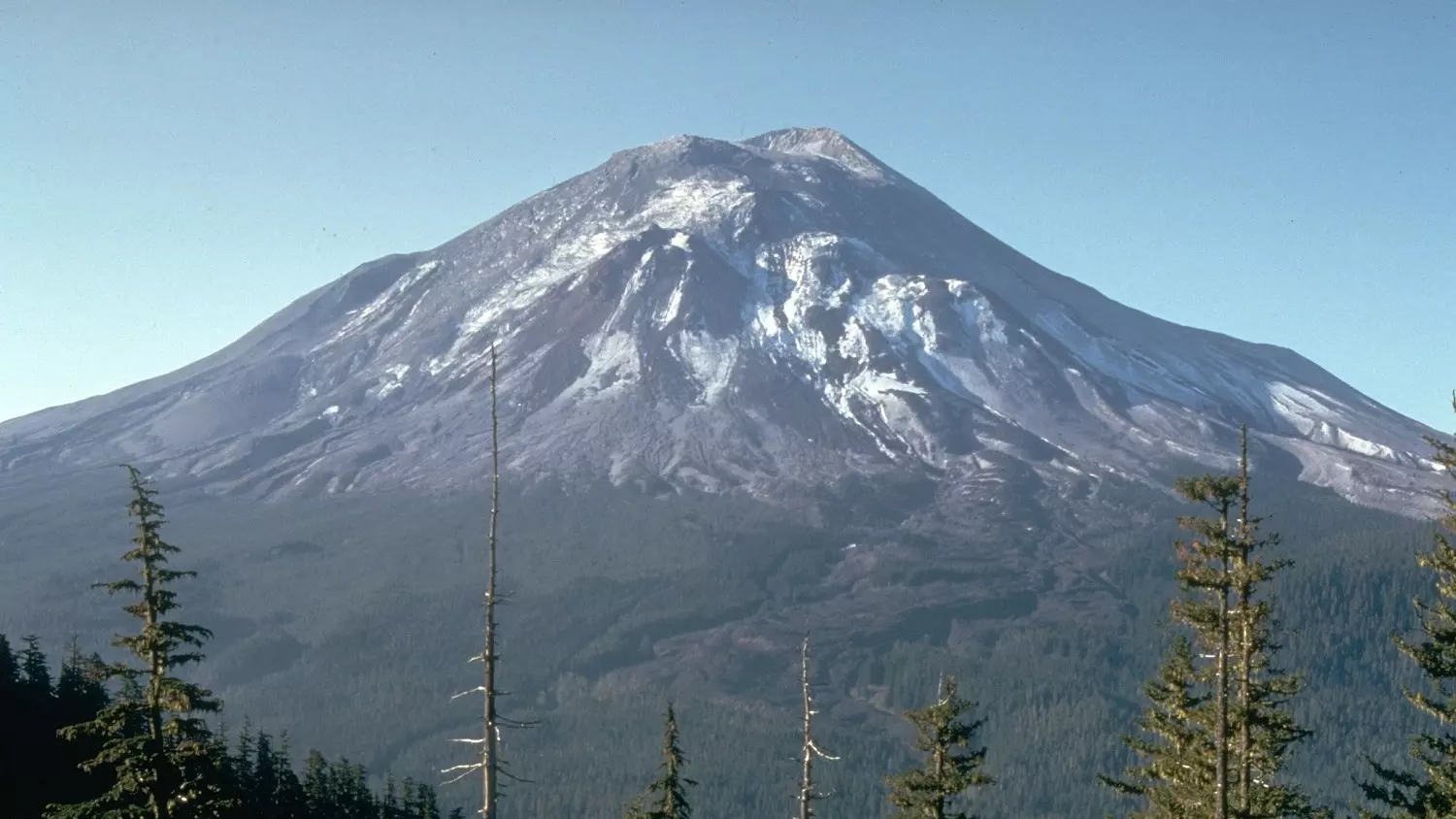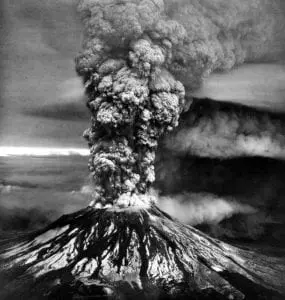It was a typical Sunday morning in mid-May in south Seattle: mostly sunny with scattered clouds. Our church service didn’t start until 10 AM, so my wife and I were lazily lying in bed. Suddenly there was a loud BOOM!
“Just a sonic boom,” I said as I pondered the possibility of getting up.
Later that morning in church, people were talking about Mt. St. Helens erupting. But we didn’t pay much attention, as it had been spewing clouds of steam and ash for over two months. It wasn’t until that evening that we learned that this was the Big One.
Indeed it was. On Sunday morning, May 18, 1980 at 8:32 AM a magnitude 5.1 earthquake under Mt. St. Helens triggered the largest landslide in recorded history, followed by a lateral blast that leveled 230 square miles of timber in 6 to 8 minutes.
Gone was Harry Truman’s Mt. St. Helens Lodge, likely swept into Spirit Lake and buried by the landslide that caused a huge wave up to 860 feet high to crash against the north shore of the lake.
The nine-hour eruption spewed out a cloud of ash that fell on five states. The cloud was so thick over Yakima that street lights came on at noon. Hot ash melted the glaciers on the side of the mountain. The mudslide that followed swept down the Toutle River, wiping out homes, roads, and bridges. Flowing into the Columbia River, the mud blocked shipping for weeks afterward.
Fifty-seven people died that morning. But it could have been much worse. A caravan of property owners was scheduled to be escorted into the “red zone” at 9 AM that morning. If the eruption had been an hour or so later the people in the caravan would’ve been killed by the landslide or subsequent blast. The mud flow following the eruption wiped out a logging camp. If it had been a workday, the loggers would have been in a dangerous place.
It was as if God were trying to get our attention through a spectacular Sunday sermon!
Most of the time the mountain isn’t visible due to cloud cover or darkness. But on this morning the peak stood out in the sunshine, making the eruption visible, not just to locals, but to the world via television, and revealed much to geologists about the dynamics of volcanoes.
Volcanoes frequently erupt around the world. But what made St. Helens significant was the fact that the destruction went so far beyond expectations. It was very sudden, and it was well documented. Scientists had been watching the mountain with anticipation ever since it began to rumble to life in March of that year. Being the subject of such intense study, we’ve made a number of interesting discoveries.
How Rapidly Layering Can Build Up
For the last 200 years or so geologists have been accustomed to thinking in terms of long ages for the formation of rock layers. A typical rate might be about one inch of rock per thousand years. But St. Helens showed that they can form much faster. A subsequent eruption on June 12 of that year deposited a 25-foot thick layer of sediment, composed of 100 to 150 thinner layers in just three hours. Further mud and ash flows cut canyons up to 700 feet deep, including some through 100 feet of pre-1980 lava, within a period of five months.
On March 19, 1982 another eruption event melted the ice and snow that had accumulated over the previous two winters. The result was a mud flow that carved out a new drainage system for the upper Toutle Valley and two lakes.
Before this, scientists had estimated that it would take 200 years to carve out a mature drainage system for the Toutle Valley. But in just nine hours rapid erosion formed new canyons and gullies, including “The Little Grand Canyon of the Toutle,” a canyon 1/40th the size of the Grand Canyon.
The Quick Return of Life to the Devastated Area
The devastation was so complete that biologists assumed it would be many years before life returned to the blast zone. But small animals survived in their burrows. Seeds blown in from surrounding areas began to sprout within a year or two. Elk herds soon returned, even though it seemed there was no forage for them.
The Unobserved Past
And yet, the St. Helens event was small compared to previous eruptions in North America. Geologists have pieced together evidence of at least three explosive eruptions in what is now Yellowstone National Park, which make St. Helens look like a firecracker in comparison.
For the last 200 years geologists have accepted the unprovable principle of uniformitarianism, which assumes that all past geologic processes have occurred at the same rate as today. According to this thinking it has taken vast eons of time for rock layers and fossils to form, and more eons for the rocks to fold and deform, and finally to erode away. Mt. St. Helens provided ample evidence that it doesn’t take millions of years to dramatically alter the earth’s surface!
The eruption of Mt. St. Helens in 1980 has provided a living laboratory of many of the processes that occurred during the Genesis Flood. Contrary to popular belief, the worldwide deluge of Genesis involved much more than just rain. Genesis 7:11 gives us a clue: “all the fountains of the great deep were broken up…” Accompanying the deluge were massive tectonic upheavals that gave rise to volcanoes, earthquakes, and tsunamis. These processes completely altered the surface of the Earth:
By these waters also the world of that time was deluged and destroyed. (2 Peter 3:6 NASB)
This combined activity provides a better account for the rock layers and fossils found all over the earth’s surface. And it happened in a very short period of time, as the Biblical account testifies. Catastrophes like the eruptions of Mt. St. Helens should serve as a reminder of God’s judgment on a sinful world.









I went to St. Helens 10 days after the eruption. I was living in Salem, OR at the time. I had 1/2 inch of volcanic ash on my truck. Anyway, I observed blades of grass and/or small weeds growing 10 days later. I saw many snakes in the river as if trying to escape or find a new acceptable home. It was amazing.